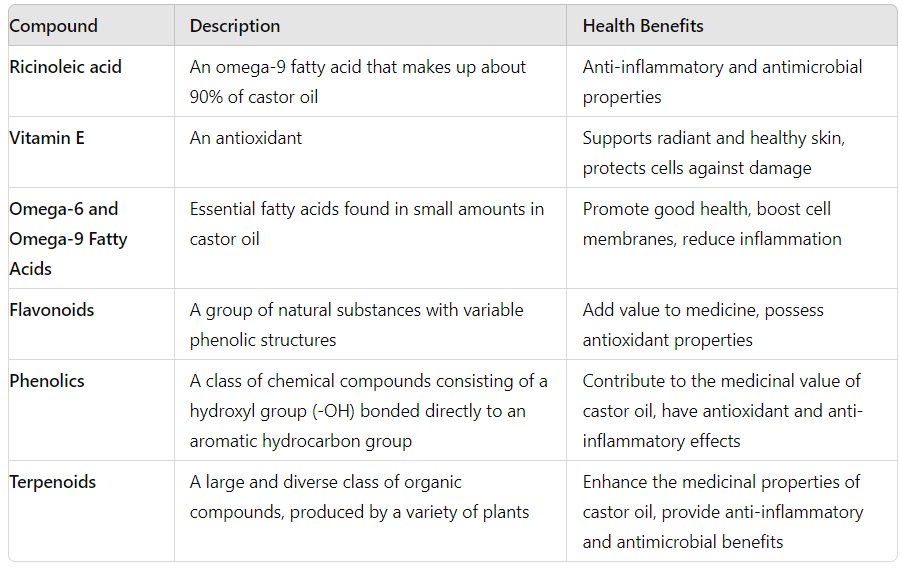Introduction
Castor oil has been used for centuries in traditional medicine. Today, it is gaining popularity again due to its applications and health benefits. Castor oil is obtained from the seeds of the castor plant, Ricinus communis. It is a pale yellow, thick liquid which is extracted from these seeds. It is considered very useful because of its mix of therapeutic properties. This guide covers the formation, nutrition, benefits, side effects, dosage, links to diseases and organs of Castor oil and much more.

What is Castor Oil?
Castor oil is a vegetable oil obtained from the seeds of castor plant. The plant is native to Africa and India but currently grows in several parts of the globe. Its seeds have been used for medications in ancient Egyptian, Indian, and Chinese civilizations. It is a rather greasy, thick, and pale yellow oil that is made up of ricinoleic acid, a form of fatty acid, which is quite uncommon but is believed to be the reason for most of its health advantages.
How is Castor Oil Formed?
The process of how castor oil is made from the castor plant to oil extraction and processing from the seeds involves many steps:
Cultivation
The castor plants are hardy. They grow well in almost all climates. But, they prefer warm, tropical ones. The mature plants develop spiny seed pods, each containing three seeds. These seeds are harvested after the pods dry up and break open.
After harvesting, the seeds are dried to reduce moisture content. This step is also necessary because it puts the seeds under optimal conditions for oil extraction.
Pressure
The dried seeds are put under cold or mechanical pressure for oil extraction. Cold pressing is the process where seeds are crushed at low temperatures. This retains their nutritional properties in the oil. However, the mechanical press uses very intense pressure to extract the oil. It might have more yield, but can also create heat that harms some good compounds in the oil.
Filtration
This oil is then filtered to purify it of impurities so that the final product obtained is pure. The filtration process may go through several stages: settling, centrifugation, and fine filtration.
Why It’s in Existence Nowadays
The interest evoked in castor oil recently, is a result of increased interest in natural and holistic health solutions. Castor oil has many uses. It helps the skin, hair, digestion, and the immune system. That’s why it piques the interest of health enthusiasts. Also, the cosmetic and pharmaceutical industries use it more. This is because they want eco-friendly products.
Nutritional Profile


Benefits
Skin Health
Castor oil is such a diverse natural remedy that has many benefits for the skin. Castor oil, due to its thick consistency, serves as a great moisturizer by locking moisture inside the skin. It forms a protective barrier on the surface of the skin that prevents the loss of moisture, hence keeping the skin well-hydrated. Castor oil can help kill acne-causing bacteria, reducing breakouts. The anti-inflammatory properties also struggle with redness and swellings, hence providing relief from irritation caused by acne. Among other benefits, castor oil improves wound healing, which allows it to be used in treating hot sores and any other small wounds. This is done by keeping the wounds moist, helping in the expulsion of pus from the body and reducing the inflammation, hence improving the healing process.
Hair Health
Castor oil is very famous for its different uses in hair care routines. The major advantages associated with castor oil are that it enhances hair growth. In fact, castor oil stimulates hair follicles by increasing the amount of blood flow in the scalp, which in turn promotes the growth of hair. Furthermore, if castor oil is used with coconut oil, then its efficiency against dandruff is increased. The oils have antifungal properties that combat dandruff and other infections of the scalp, thus keeping the scalp in good health and removing flakes. Besides this, castor oil is an excellent conditioner for your scalp. Castor oil moisturizes from within and does not let the scalp become dry and flaky. It works just like a balm, soothing the scalp, keeping it really well moisturized and nourished.
Digestive Health
Perhaps the most common use of castor oil is its natural laxative effect. This strong medicine works perfectly in helping with constipation. The main substance causing this effect is ricinoleic acid, which acts on the intestines. If castor oil is consumed, it will help in the stimulation of muscles inside the intestines. When this happens, there is an increase in the movement of the intestinal walls, thus accelerating bowel movements. It does this by allowing stool to pass easily through the digestive tract, hence relieving constipation. The castor oil has been used over several decades in treating constipation as it is an efficient way of ensuring regularity and health in digestion.
Anti-Inflammatory and Anti-Microbial Properties
Castor oil has anti-inflammatory properties that are essential in reducing pain and swelling. On sore muscles or joints, it in great ways, brings down inflammations that result from a condition like arthritis. Its anti-inflammatory properties soothe the discomfort by offering coolness to the area of concern. Not forgetting all these benefits, castor oil boosts immunity due to its antimicrobial effects. It fights mild infections and helps in the prevention of infection and treats cuts and wounds. This makes the castor oil a versatile, most useful ingredient for any kind of natural health care, as it renders anti-inflammatory benefits and helps to improve the immunity system.
Side Effects
Although castor oil is greatly beneficial, it is always good to be aware of its side effects and allergies. People can be allergic to castor oil in many ways. In some, this allergy manifests itself through reddening, itching, or inflammation on the skin. Some get itching, normally at the place where the oil was applied, which might cause unbearable discomfort.
There are digestive problems cited above that can be caused by heavy internal use of castor oil. It might produce diarrhea that may bring about dehydration and electrolyte imbalance with an excessive dose as a purgative. Other side effects taken as a purgative include cramps and nausea by some individuals.
Use castor oil with utmost care during pregnancy. Since it can cause uterine contractions, the pregnant ladies should consult a health professional before taking up to get all required precautions and be better guided in using it safely.
Dosage
The dosage of castor oil depends on the purpose for which it will be put-
For Internal Usage
For treating constipation, one can consume 1-2 teaspoons of this oil. However, it is recommended that one starts with a low dose and changes it as per their needs. Consult your doctor for the proper dosage.
For Topical Application
Skin applications: A small amount of Castor Oil is applied over the skin to react. It can be done alone and in combination with any other oil to increase the effect.
Hair Treatments: A bit of Castor Oil is massaged onto the scalp and hair. It is left for a few hours or overnight and then rinsed out with shampoo.
How to Use Castor Oil During Cooking
Castor oil can be taken by mouth to add some flavor with caution, as it has a very strong taste, and in large quantities, it may give an upset stomach.
Flame and Heating Instructions
Low to Medium Flame: Heat castor oil gently because it has a low smoke point at about 200°C or 392°F. Use a low to medium flame. This keeps its nutrients and prevents harmful compounds.
Don’t Heat Much: Don’t heat oil much. High heat breaks down its good ingredients and makes harmful compounds.
Culinary Uses
Salad Dressings: Use a little castor oil to make your salad dressings. Use it as a mixture with other oils, such as olive oil, or simply dilute to decrease its pungency.
Baking: This can be used for baking by replacing a part of some other cooking oil with castor oil in the recipe. It is thick in consistency and hence may add moisture to the baked food.
Sauteing: Castor oil can be used in a limited amount while sautéing vegetables over a low to medium flame. This must be well incorporated with other oils, lest it may dominate the food.
How to Use and Ways of Using Castor Oil
Skin moisturizer: You can put some drops of castor oil on dry parts of your skin and massage gently until it is absorbed. You can use it alone or mix it with other carrier oils, such as coconut or almond oil.
Hair Treatment: Massage the scalp and hair with castor oil, focusing on the roots and ends. After keeping it for a few hours or overnight, wash it with a mild shampoo. With regular use, this will regenerate hair growth and also refresh the scalp.
Pain Relief: Apply castor oil over sore muscles or joints. Apply a heat pad over it for 20-30 minutes. The warmth will make the oil react and go deeper into the skin. This works as a useful relief from both pain and inflammation.
Laxative: Taking 1-2 teaspoons of castor oil on an empty stomach relieves constipation. You can also take it with at least one glass of warm water or juice to improve the taste.
Body Immunity: Add a few drops of castor oil in any juice or water for body immunity. Start using a small dose and slowly increase the dose as needed.
Conclusion
Castor oil is a versatile and natural remedy. It has wide health benefits. These range from skin and hair to digestion and the immune system. Responsible applications require considering the dosage and possible side effects. Be it topical, through cooking, or taken orally, castor oil could possibly be just the ticket added to your health and wellness regimen.
As with all natural remedies, one should ask healthcare professionals for advice. They should do this before trying any new supplement or treatment. It’s important in case it may not be suitable for you. You know what castor oil can do and where to use that knowledge. You will use the benefits of this oil to make yourself healthier and live better.

